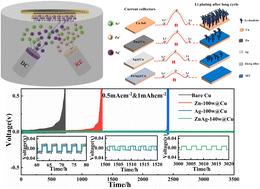磁控溅射法制备稳定锂金属电池用亲锂锌银合金膜改性Cu集流剂
IF 9.5
2区 材料科学
Q1 CHEMISTRY, PHYSICAL
引用次数: 0
摘要
由于其特殊的能量密度和较低的制造成本,无阳极锂金属电池的研究已经取得了重大进展。然而,显著的晶格失配、较差的亲锂性和Cu CCs的表面粗糙度导致锂沉积和枝晶形成不均匀,严重影响电池的循环寿命和安全性。调控锂沉积/剥离行为的核心策略在于亲锂界面或功能涂层的构建。在本研究中,采用高效磁控溅射技术在铜cc表面共沉积了均匀致密的Zn-Ag合金膜。这种低温、大面积、高度均匀的工艺显著降低了锂成核过电位和局域电流密度,从而促进了稳定、无机为主的固体电解质界面相(SEI)的建立。实验结果表明,在半电池测试(0.5 mA cm−2,1 mAh cm−2)中,改性ZnAg@Cu CCs在800次循环中保持了98.43%的平均库仑效率。此外,对称电池在相同条件下循环3500小时后表现出18 mV的超低电压滞后。值得注意的是,与磷酸铁锂(LFP)阴极配对的电池在0.5C下循环100次后,容量保持率达到92.12%。本研究为无阳极金属电池集流器的界面工程提供了一种创新的解决方案,具有高效率制造和性能优化的双重优势。本文章由计算机程序翻译,如有差异,请以英文原文为准。

Lithiophilic Zn–Ag alloy film-modified Cu current collector prepared by magnetron sputtering for stable lithium metal batteries
Significant research efforts have been directed toward anode-free lithium metal batteries, primarily attributed to their exceptional energy density and low manufacturing costs. Nevertheless, significant lattice mismatch, poor lithiophilicity, and surface roughness of Cu CCs result in non-uniform lithium deposition and dendrite formation, critically undermining the cycle life and safety of the batteries. The core strategy for regulating lithium deposition/stripping behavior lies in the construction of lithiophilic interfaces or functional coatings. In this study, a highly efficient magnetron sputtering technique was employed to co-deposit a uniform and dense Zn–Ag alloy film on copper CCs. This low-temperature, large-area, and highly homogeneous process significantly reduced the lithium nucleation overpotential and localized current density, thereby promoting the establishment of a stable, inorganic-dominated solid electrolyte interphase (SEI). Experimental results demonstrated that the modified ZnAg@Cu CCs retained an average coulombic efficiency of 98.43% over 800 cycles in half-cell tests (0.5 mA cm−2, 1 mAh cm−2). Furthermore, symmetric cells exhibited an ultralow voltage hysteresis of 18 mV after 3500 hours of cycling under identical conditions. Notably, full cells paired with a lithium iron phosphate (LFP) cathode achieved a 92.12% capacity retention after 100 cycles at 0.5C. This study presents an innovative solution for the interfacial engineering of current collectors for anode-free metal batteries, offering dual advantages of high-efficiency fabrication and performance optimization.
求助全文
通过发布文献求助,成功后即可免费获取论文全文。
去求助
来源期刊

Journal of Materials Chemistry A
CHEMISTRY, PHYSICAL-ENERGY & FUELS
CiteScore
19.50
自引率
5.00%
发文量
1892
审稿时长
1.5 months
期刊介绍:
The Journal of Materials Chemistry A, B & C covers a wide range of high-quality studies in the field of materials chemistry, with each section focusing on specific applications of the materials studied. Journal of Materials Chemistry A emphasizes applications in energy and sustainability, including topics such as artificial photosynthesis, batteries, and fuel cells. Journal of Materials Chemistry B focuses on applications in biology and medicine, while Journal of Materials Chemistry C covers applications in optical, magnetic, and electronic devices. Example topic areas within the scope of Journal of Materials Chemistry A include catalysis, green/sustainable materials, sensors, and water treatment, among others.
 求助内容:
求助内容: 应助结果提醒方式:
应助结果提醒方式:


